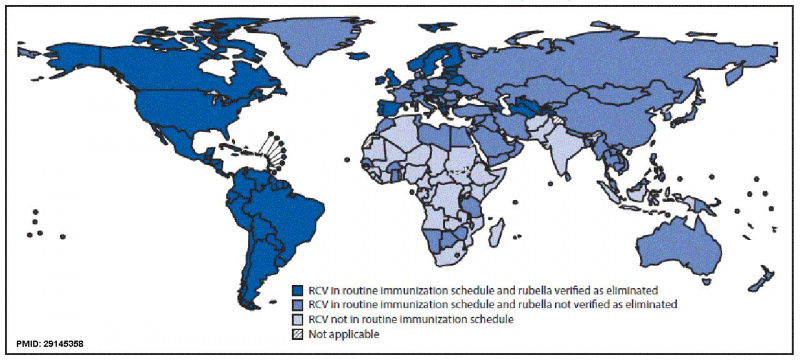File:Rubella control map 2000-2016.jpg
From Embryology

Size of this preview: 800 × 360 pixels. Other resolution: 1,280 × 576 pixels.
Original file (1,280 × 576 pixels, file size: 96 KB, MIME type: image/jpeg)
Progress in Rubella and Congenital Rubella Syndrome Control and Elimination - Worldwide, 2000-2016
Abstract:
- "Although rubella virus infection usually causes a mild fever and rash illness in children and adults, infection during pregnancy, especially during the first trimester, can result in miscarriage, fetal death, stillbirth, or infants with a constellation of congenital malformations known as congenital rubella syndrome (CRS). Rubella is a leading vaccine-preventable cause of birth defects. Preventing these adverse pregnancy outcomes is the focus of rubella vaccination programs. In 2011, the World Health Organization (WHO) updated guidance on the preferred strategy for introduction of rubella-containing vaccine (RCV) into national immunization schedules and recommended an initial vaccination campaign, usually targeting children aged 9 months-14 years (1). The Global Vaccine Action Plan 2011-2020 (GVAP), endorsed by the World Health Assembly in 2012, includes goals to eliminate rubella in at least five of the six WHO regions by 2020 (2). This report updates a previous report (3) and summarizes global progress toward rubella and CRS control and elimination from 2000 to 2016. As of December 2016, 152 (78%) of 194 countries had introduced RCV into the national immunization schedule, representing an increase of 53 countries since 2000, including 20 countries that introduced RCV after 2012."
Reference
Grant GB, Reef SE, Patel M, Knapp JK & Dabbagh A. (2017). Progress in Rubella and Congenital Rubella Syndrome Control and Elimination - Worldwide, 2000-2016. MMWR Morb. Mortal. Wkly. Rep. , 66, 1256-1260. PMID: 29145358 DOI.
Copyright
CDC https://www.hhs.gov/open/index.html
Cite this page: Hill, M.A. (2024, April 25) Embryology Rubella control map 2000-2016.jpg. Retrieved from https://embryology.med.unsw.edu.au/embryology/index.php/File:Rubella_control_map_2000-2016.jpg
- © Dr Mark Hill 2024, UNSW Embryology ISBN: 978 0 7334 2609 4 - UNSW CRICOS Provider Code No. 00098G
File history
Click on a date/time to view the file as it appeared at that time.
| Date/Time | Thumbnail | Dimensions | User | Comment | |
|---|---|---|---|---|---|
| current | 10:48, 5 April 2018 |  | 1,280 × 576 (96 KB) | Z8600021 (talk | contribs) | ==Progress in Rubella and Congenital Rubella Syndrome Control and Elimination - Worldwide, 2000-2016== "Abstract Although rubella virus infection usually causes a mild fever and rash illness in children and adults, infection during pregnancy, especial... |
You cannot overwrite this file.
File usage
The following page uses this file: